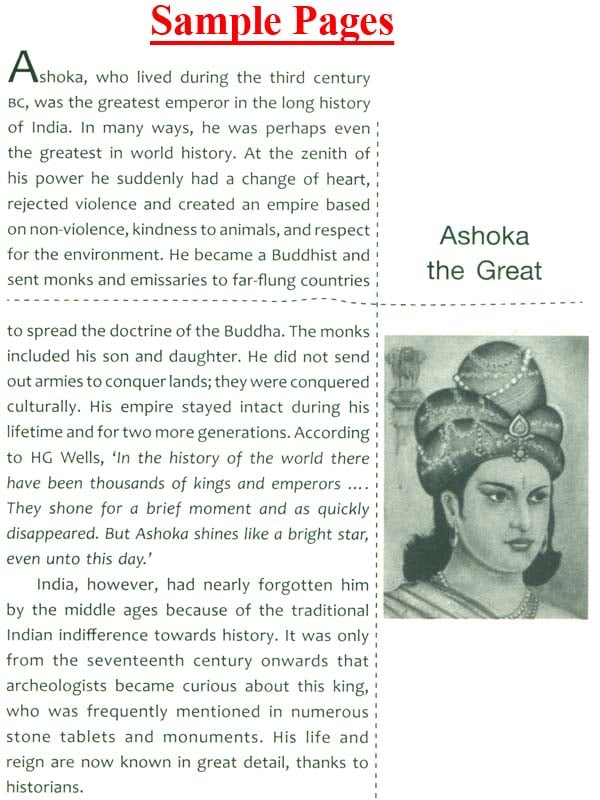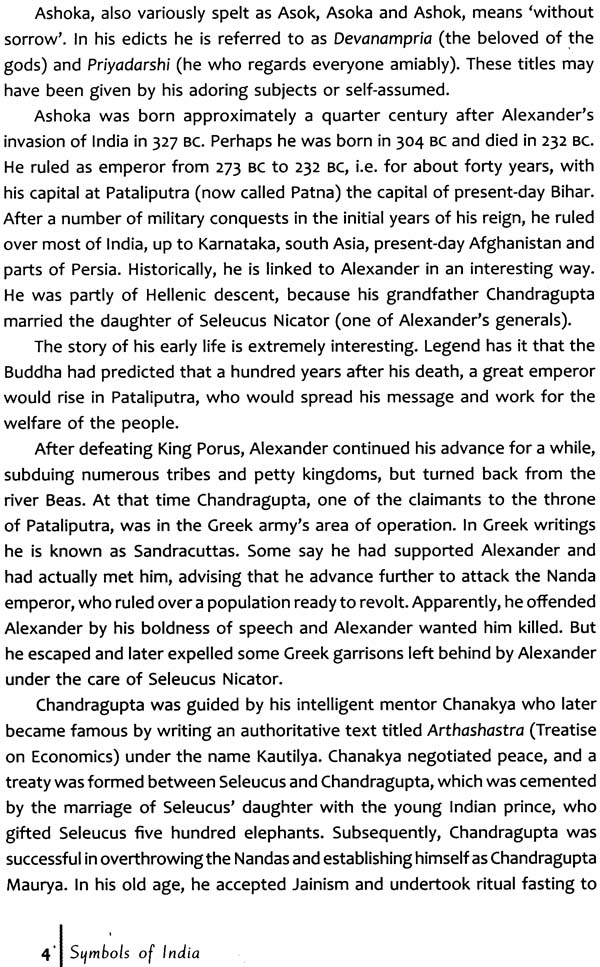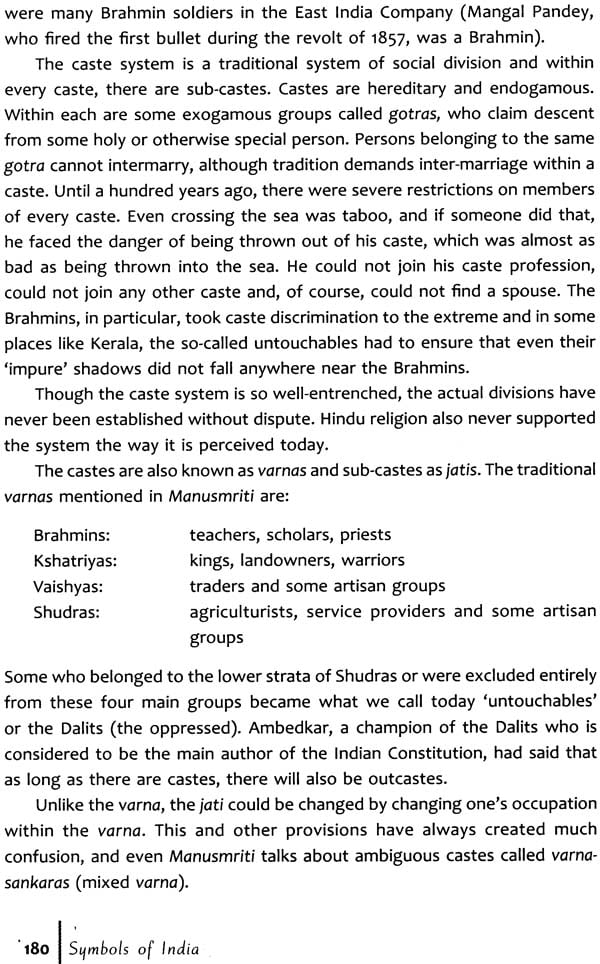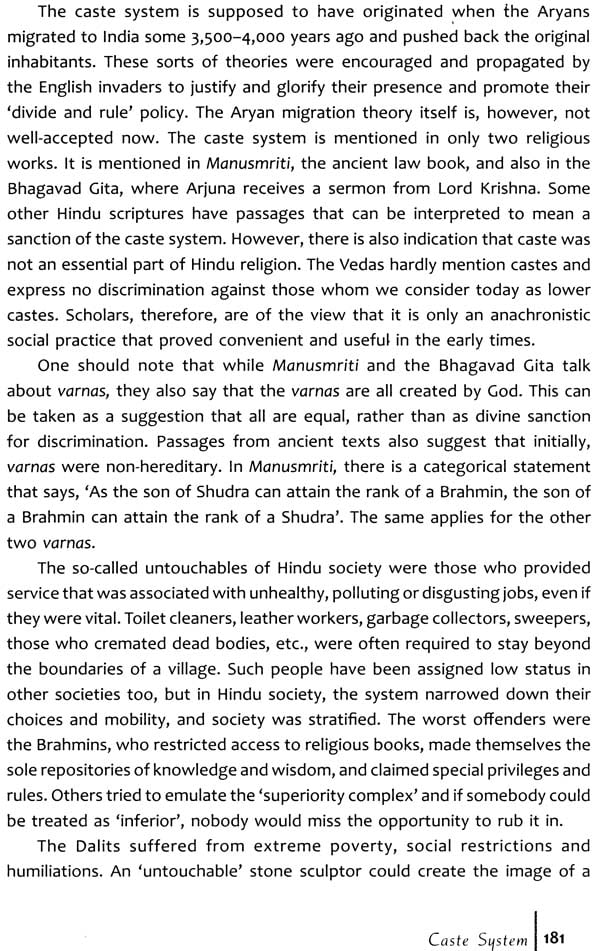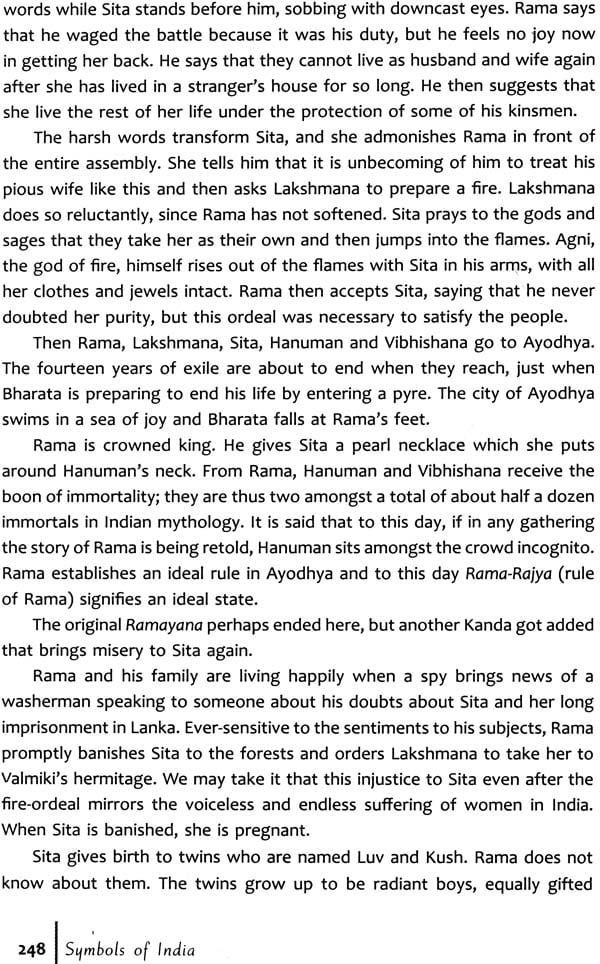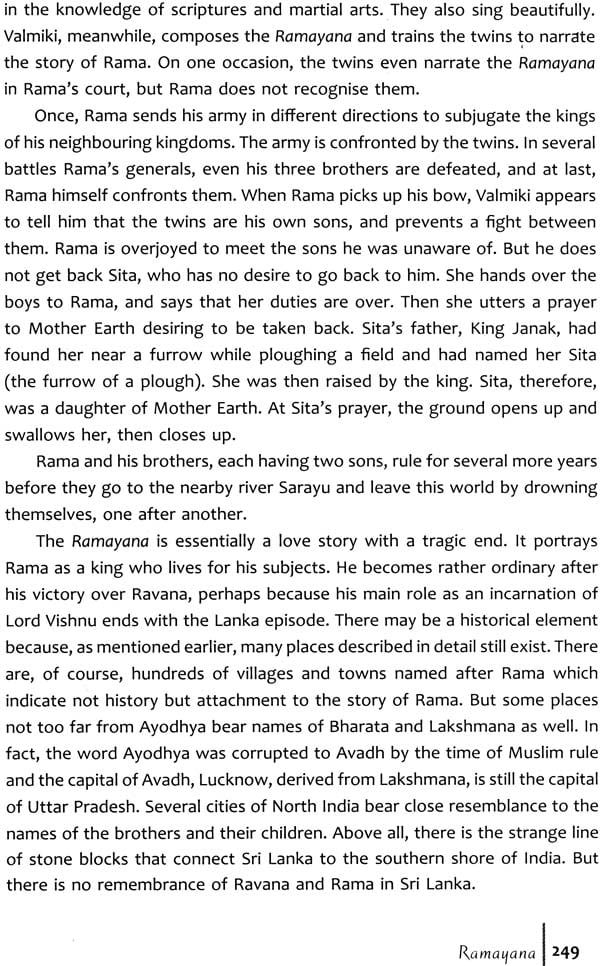
Symbols of India
Book Specification
| Item Code: | NAO094 |
| Author: | Hem Shanker Ray |
| Publisher: | Rupa Publication Pvt. Ltd. |
| Edition: | 2012 |
| ISBN: | 9788129117793 |
| Pages: | 427 |
| Cover: | Hardcover |
| Other Details | 8.5 inch X 5.5 inch |
| Weight | 710 gm |
Book Description
All of them can trace their roots back to India, even if some have now migrated to other cultures as well. Symbols of Indio explores the origin, development and relevance of these and many others. Some of them, like the Bhagavad Gita, have been around since centuries; others, like Bollywood, are relatively new. Some, like the curry, have become internationally renowned, while others, like the maharaja, seem to be on their way out.
More than eighty symbols taken from every age, place and section of Indian society have been discussed in this book. With not-so-well-known facts and vivid descriptions, this book will appeal to all those who want to gain a better understanding of what India is all about.
About the Author
Professor Hem Shanker Ray, an alumnus of IIT Kharagpur, has done his Msc and PhD in Metallurgy from the University of Toronto, Canada. He was assistant professor at IIT Kanpur; senior technologist and manager of R&D, Pilkington Bros. Ltd.; professor of metallurgical engineering and dean of students' affairs at IIT Kharagpur; director of the Regional Research Laboratory, Bhubaneshwar; an emeritus scientist at Central Glass & Ceramic Research Institute, Kolkata; and a member of the editorial board of Everyman's Science and Research Advisory Council, JNARDDC, Nagpur. He has won several awards for his work on metallurgy and has published many papers and articles. He also writes fiction, in English and Bengali, and currently lives in Kolkata.
Foreword
India has been a land of interest and attraction for millennia. We have read in history books of visitors who wrote about what they experienced here. Fa-Hien, Hieun Tsang, AI Baruni, Abbe Dubois, Catherine Mayo ... the list goes on. Some came and settled here, absorbed the customs and culture and added to them: the Arabs, Persians, Parsis, Orientals, Mughals, Portuguese, French, British and many others. In many instances, the traveller or visitor experienced but one region of this vast continent and generalized what he saw as representative of India. Even the very name India or Hindustan has been given to us by the outsider. We are a country that was, until recently, an ensemble of political units stitched together, first in parts and just a few centuries ago, as one vast country - sandwiched between the Himalayas and the Indian Ocean, and straddling west Asia and south-east Asia.
But when we look at India from the spectroscope of faith, culture and customs, we find it to be at once both a mosaic and a melting pot. The spectrum spreads out the rainbow even as it focuses attention on a spot. The rainbow here is in the languages, subcultures, faiths and follies. The spot is the basic Indian-ness, forged through centuries of living together and sharing. This is what the cliche 'unity in diversity' means, this is also why there is truth in the oft-repeated statement: 'Anything you write about India is at once both right and wrong.
So then, how does one capture India in a book? Travel books like Fodor's Guide to India or the Lonely Planet series give you hints. But their focus is still on specific towns, regions and landscapes, they tell you how to get there and what to do. This is as it should be for a travel book or a tourist guide book. Even as you follow their instructions to the T and get to some place in India, what do you see? Both the rainbow and the spot. You see a kaleidoscope.
What is this kaleidoscope made of? Each component is a symbol, representing something both catchy and deep. How, then, does one describe something both in its breadth and depth? It is here that symbols come in use. And Professor Hem Shanker Ray has craftily used this technique to let us catch glimpses of India. Not through a handful of symbols but with over six dozen of them, from the trivial to the profound.
Casting in symbols, models and themes is not new to Prof Ray. An accomplished and successful scientist, he wields the pen with accuracy and art. His earlier books such as Bubble Bubble or The Ferum Hunters narrated science in an entertaining, yet educative way. The present one follows the style. Even after having lived in India for three-score years, and seen most of its length and breadth, I find in each page of the book something new that I did not know nor realise. Is that not the purpose of an author - to entertain, yet educate?
Some readers may find fault with Prof Ray for having missed out something that too symbolises India. But then the reader did not write the book. As they say, it is easier to be a critic than an author. Samuel Johnson said, 'You may abuse a tragedy though you cannot write one' and Grady Little said, 'A lot of people have the answers after the results come in'. We Indians, as Amartya Sen points out, are an argumentative lot. This is what makes us Indians. With that in mind, go ahead and have a happy reading. Thank you, Hem Shanker, for such a great collection of the symbols of India.
Preface
There is a story about how we came to inhabit this land called India. After God created the world and the different races, one day He decided to allocate lands to the different populations. He desired that representatives of different groups should go to Him at sunrise on a particular day and speak out about their preferences.
Many assembled that morning, even before sunrise, and when the time came, the good Lord listened to everybody patiently. The English, small in number, desired to live on a small secluded island away from others, and particularly from the French who, fond as they were of good living, pleaded for some fine vineyards and sunny beaches. The Chinese, very large in number, wanted a vast landmass and a coastline and, like the others, they were given a land to their liking, even though they found a large desert there. The Russians wanted a cold climate that was suited for vodka, as well as some desolate area where troublemakers and undesirables could be exiled. God, in His infinite wisdom, satisfied everybody. The happy and playful Africans got the forests, waterfalls and the Savannah so that they could live close to nature. The brave men of the race known today as Red Indians received the gift of a land full of bisons, turkeys and falcons - all the flora and fauna they loved. There were no Americans then. The Arabs chose the deserts, where they could wear magnificent flowing robes, ride their beloved camels and pick the juiciest dates.
The easy-going Indians, who were habitually callous about appointments, forgot the important date and woke up late as usual. Their leaders eventually remembered around noon that they were to be given a homeland. By the time they went to kneel before Him, the day was coming to an end. By then, all others had left and God was planning to rest for a while.
The Almighty was quite upset to see these latecomers. 'My children, why are you so late? I have given away all the land that was there for distribution. What can I do now?' He said in exasperation.
The Indians hung their heads down in shame and, with tears in their eyes, started leaving. God, however, always had a soft spot for them, and after they had gone a distance, He called them back and said, 'Children, you are strange indeed. You take it easy when others are excited and you are obsessed with things that the others think unimportant. You have needs but you do not crave. When others run away from me in fear, you come to me seeking love. You can be annoying indeed, but I cannot stop loving you because you remain close to my heart.' Then He added, 'Well, this is what I can do. I had kept some land for myself and now I give the same to you.
And what a land they got - God's own land! With a total landmass of about 3.3 million sq. km, it is smaller than Russia, Canada, China, including Tibet, the United States, Brazil and Australia. Yet, India has wonderful and unique variety in the landscape and the population. Lofty, snow-covered Himalayan mountains with the highest peaks guard the north, while the three seas that encircle the southern part give a long coastline. Some of the world's longest rivers flow through its fertile lands: amongst them are the Ganges (2,510 km), the Indus (2,900 km) and the Brahmaputra (2,900 km). There are countless other rivers, hills and forests, fertile plains and remarkably rich flora and fauna. There is also a desert in the north-west.
India has some of the world's hottest, coldest, driest and wettest areas. The fascinating variety in everything makes India virtually a continent, even though some one-fifth of previously undivided India now makes Pakistan in the north-west and Bangladesh in the east. Amongst the population, one can find blue-eyed blonds in the north and dark skins and curly hair in the south. They have Aryan, Negroid and Mongoloid features, as well as fascinating combinations. In the forests, where tribals dominate, one finds features of some early Indians. There are isolated tribals in the Andaman and Nicobar islands in the Bay of Bengal, who share features with Australian aboriginals. A popular theory is that Aryans from Europe migrated to India via the Middle East some ten thousand years ago and overpowered the original inhabitants. However, some people also propose that the migration may have been the other way.
Food habits, clothes, looks, culture, language and dialect change every 150 kilometres or so in this country, whose population of over 1.1 billion is second only to China (1.3 b). The US, with 0.3 billion, is a distant third. There are over eight hundred distinct dialects and twenty-two well-developed languages that are officially recognised. Often, the scripts are also very different, and so are the symbols for the numerals. The Indian currency notes carry writings in sixteen different scripts.
There is, however, a strange unity in this diversity. A poor Hindu village woman from the region of Jammu in the north will travel three nights and three days in a train to reach Kanyakumari, the southern tip of India. But she would have no problem offering her prayers in a Hindu temple there, because she would be familiar with all the rituals. All the major religions of the world are represented here. For the Jewish people, often persecuted elsewhere, India has been a safe haven. So it was for the Zoroastrians, who fled from Persia after Muslim invasion in the eighth century and were given asylum by a king called Jadi Rana in Sanjan on the Gujarat coast. India is for everyone.
This book is a commentary on symbols that epitomise the notion and nation of India. While it has been written over the past three years, the constituent ideas and themes have emerged through readings and observations over a much longer period.
The inspiration appears to be two-fold. First, it comes from a sense of wonder and inquisitiveness at the wide range of animate and inanimate manifestations of India's diversity and heritage. Second, it is an interest in personalities and events that have underpinned the Indian nation and Indian identity.
As one researches the symbols and the various aspects of India they symbolise, several themes emerge that make India special, and at times unique, in the comity of nations. This leads one to research these themes and juxtapose the symbols against these. Hence, the consequent approach has been bifocal. On the other hand, it highlights the higher order themes and establishes their linkages with the individual symbols.
Much has been said and written about India. Well-researched views abound on its political relevance, economic standing, scientific contributions, cultural heritage and exoticist traditions. While this book does not claim to add to this body of scholarly work, there are certain themes discussed that make India special and find refrain throughout the book.
First and foremost is the notion of India that goes beyond political boundaries. One of the earliest references to India was made by the ancient Greeks, who called the country Hind (the land beyond the Hindukush mountains). The notion of the Indian nation was alive in the first millennium A.D. during the period of Buddhist and Hindu political domination. During the Islamic reign for much of the second millennium, the historic treatises sponsored by Babur and Akbar make references to the notion of Hind. Columbus and Vasco da Gama undertook arduous expeditions in search of the elusive sea route to 'India'. And all this while, India was never under a single unified political regime.
Second is the unabated relevance of India over the ages. Mohenjodaro and Harappa were among the first known human civilisations of scale and sophistication. In the millennia before Christ, India was the birthplace and cradle to three religions that continue to exist and flourish to this day. For much of the first millennia AD India, along with China, made up one-third of the world's GDP. Post-Renaissance, Europe engaged in a race to tap into India's resources, and Britain held India as the jewel in its crown for over a century. While Gandhi's approach inspired nations during the first half of the twentieth century, Nehru kept India politically relevant during the decades after Independence. Now, after a hiatus of a few decades, India is emerging as an economic superpower driven by reforms and consumption patterns. No other nation, with the notable exception of China, has maintained such strong relevance through the known history of humankind.
The third noteworthy theme is the breadth of contributions that India has made to the world. The exoticist contributions are generally well-known. The scientific, literary and political contributions are less so. The mathematical work of Aryabhatta, and Brahmagupta towards the conceptualisation of 'zero', and the understanding of gravitation travelled to the West through Arabic mathematicians, and had deep influence on Western thinking. Kautilya's was among the early profound works on statesmanship. Kalidasa's literary work during the medieval age is generally considered to be among the most lyrical. Gautama Buddha and Mahavira taught the world the concept of ahimsa, and Ashoka propagated it far and wide. Gandhi's credo of non-violence captivated political activists throughout the twentieth century. India's adult franchise and secularism are role models to the democratic world. More recently, the post-reform era has witnessed the blossoming of Indian entrepreneurship and Indian businesses are now providing new models in globalisation.
The final theme is the diversity of India - so entrenched and interwoven in India's identity, yet so intriguing and, at times, worrying. This diversity manifests itself in nearly all aspects of life spanning language, cultural and social mores, family lifestyles and structures, food habits, political structure and alignments, economic well-being and religious beliefs. As Naipaul explains, India is made up of thousands of interest groups, all adding up to a million mutinies that have somehow learnt to exist together. The traditional European view of India has always challenged this coexistence and predicted the breaking apart of the Indian nation state. Secularism, adult franchise and the country's democratic structure have kept the nation together for the past six decades. It is clear that the biggest danger in the coming decades will be from economic disparity. While secularism will be an able foil to communal forces, the antidote to economic diversity and disparity is less clear.
In order to write on symbols of India, I feel that it is important to understand the meaning of the word 'symbol'. The word 'symbol' is derived from the Greek word symbolon, with the root words syn, meaning 'together', and bole, meaning 'a throw', having the approximate meaning of 'to throw together', literally 'a coincidence'. The word 'symbol' is often used in a confusing manner. A symbol is different from a sign or a metaphor. Signs are literal, symbols are not. A symbol inevitably has several layers of meaning. The more profound the symbol, the higher the complexity of the layers of meaning. Similarly, a symbol is different from a metaphor in that its application is left as an unstated suggestion. Unlike a literary metaphor, it is simplistic to say that a symbol stands for an idea and that it is a convenient substitute for a fixed meaning. Usually, a symbol is a substantial image in its own right, around which further significances may gather depending on differing interpretations.
Such an understanding of the word 'symbol' introduces a few challenges in this work. First, symbols had their own significance even before one could attribute additional significances. Hence, it would be important to bring out the 'standalone significance' of the symbols chosen to symbolise India. Second, the additional significances would depend on interpretation. Hence, one needs to accept the fact that there would be errors of omission, where the author would have ignored a particular interpretation of a symbol. Finally, and most critically, the book needed a seamless interplay between the 'standalone significance' of a symbol and its greater significance that alluded to some aspect of India.
Contents
| Foreword | xi |
| Preface | xiii |
| Introduction | xxi |
| THE NOTION OF INDIA | |
| Ashoka the Great | 3 |
| Ayurveda | 10 |
| Classical Dances | 15 |
| Gandhi | 19 |
| Gautama Buddha | 28 |
| Mother Teresa | 35 |
| Namaste | 38 |
| Rabindranath Tagore | 41 |
| Sufism | 50 |
| Varanasi | 53 |
| Swami Vivekananda | 57 |
| THE INDIAN IDENTITY | |
| Ajanta Cave Paintings | 67 |
| Delhi | 72 |
| Diwali | 76 |
| Elephant | 79 |
| Ganesha | 83 |
| Ganga (The Ganges) | 88 |
| Gita | 91 |
| Himalayas | 101 |
| Holi | 103 |
| India Gate and the Gateway of India | 106 |
| Indian Railways (IR) | 108 |
| Mantra | 112 |
| The National Anthem and National Songs | 117 |
| The National Emblem | 123 |
| National Flag | 125 |
| Neem | 128 |
| Number Zero (O) | 131 |
| Rashtrapati Bhavan | 133 |
| Ratha Yatra Festival | 135 |
| Sari | 142 |
| Satyajit Ray | 145 |
| Swastika | 149 |
| Taj Mahal | 152 |
| Thanjavur Temple | 159 |
| The Holy Cow | 162 |
| Tiger | 166 |
| Turmeric | 169 |
| Yoga | 171 |
| FOUNDATIONS OF INDIAN SOCIETY | |
| Caste System | 179 |
| Classical Music | 184 |
| Hinduism | 192 |
| Indo-Islamic Heritage | 196 |
| Mahabharata | 207 |
| Mela | 225 |
| Nalanda | 228 |
| Panchatantra | 230 |
| Ramayana | 235 |
| Sanskrit | 251 |
| Secularism | 254 |
| The Sikh | 259 |
| Vedas | 272 |
| EXOTIC INDIA | |
| Bangles | 281 |
| Bindi | 284 |
| Curry | 286 |
| Darjeeling Tea | 289 |
| Hindu Wedding | 293 |
| Kohl | 296 |
| Kamasutra | 298 |
| Khajuraho | 301 |
| Kohinoor | 304 |
| Krishna | 308 |
| Lotus | 316 |
| Mango | 318 |
| Nataraja | 321 |
| Paan | 324 |
| Peacock | 327 |
| Rangoli | 329 |
| Rudraksha | 331 |
| Spices and Herbs | 333 |
| Turban | 340 |
| RISING INDIA | |
| Auto-rickshaw | 345 |
| Bangalore (Bengaluru) | 348 |
| Basmati Rice | 352 |
| Bollywood | 354 |
| Indian English | 359 |
| Indian Institutes of Technology (IITs) | 361 |
| FADING SYMBOLS | |
| Ambassador car (The Amby) | 367 |
| Bullock cart | 369 |
| Dhyan Chand - the Wizard of Hockey | 374 |
| Maharaja | 379 |
| Rope Trick | |
| Acknowledgements | 382 |
| Index | 383 |
